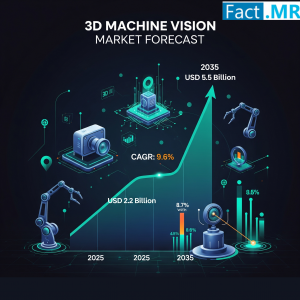3D Machine Vision Market Is Estimated to Reach USD 5.5 Billion by 2035 | Fact.MR Analysis
Analysis Of 3D Machine Vision Market Covering 30+ Countries Including Analysis Of US, Canada, UK, Germany, France, Nordics, GCC Countries
ROCKVILLE, MD, UNITED STATES, August 21, 2025 /EINPresswire.com/ -- Fact.MR today released its latest report on the 3D Machine Vision Market, providing comprehensive insights into the global market’s robust growth driven by increasing demand for automation, quality inspection, and advanced robotics across industries. Valued at USD 2.2 billion in 2025, the market is projected to grow at a compound annual growth rate (CAGR) of 9.6%, reaching USD 5.5 billion by 2035. This expansion underscores the critical role of 3D machine vision in enhancing precision, efficiency, and reliability in industrial and non-industrial applications.For More Insights into the Market, Request a Sample of this Report: https://www.factmr.com/connectus/sample?flag=S&rep_id=8388
Market Outlook and Growth Projections:
The 3D machine vision market is set for significant growth from 2025 to 2035, fueled by the rising adoption of automation and the need for accurate, high-resolution inspection systems. 3D machine vision systems, which combine hardware, software, and integrated technologies to create three-dimensional digitized models, are increasingly preferred over 2D systems for their ability to provide precise measurements of complex structures. The report projects the market to grow from USD 2.2 billion in 2025 to USD 5.5 billion by 2035, with a CAGR of 9.6%. This growth is driven by advancements in AI, robotics, and smart camera technologies, creating substantial opportunities for stakeholders in manufacturing, automotive, and pharmaceutical sectors.
Key Drivers Fueling Market Demand:
The primary drivers of the 3D machine vision market include the growing complexity of manufacturing processes, which demands precise inspection and measurement capabilities beyond human capabilities. The report highlights the increasing adoption of vision-guided robotic systems in industries like automotive, pharmaceuticals, and food and beverage, driven by the need for efficiency and quality control. The surge in demand for automation, with the global machine vision market projected to reach USD 41.74 billion by 2030 at a CAGR of 13%, supports the growth of 3D systems, particularly in North America, where the U.S. market is expected to grow at over 12% CAGR.
Challenges and Restraints in the Sector:
Despite its promising outlook, the 3D machine vision market faces challenges that could impede growth. High initial costs and complexity of implementation, particularly for small and medium-sized enterprises (SMEs), pose barriers, as advanced 3D systems require specialized expertise. The report notes that 3D systems are generally more expensive and complex than 2D systems, with integration challenges in legacy environments. Additionally, limited awareness in some developing regions and the need for high-resolution and sensitivity to handle diverse applications can restrict market penetration.
Segment-Wise Insights and Dominant Trends:
The report provides detailed segmentation analysis, identifying smart camera-based systems as a key growth segment, projected to grow at a CAGR of 5.6% due to their increasing use in 3D sensing and imaging. By product, PC-based systems dominate for their processing power, while smart cameras are gaining traction for simpler applications. By application, quality assurance and inspection hold the largest share, driven by demand in electronics and automotive sectors, with identification and predictive maintenance growing at a higher CAGR due to AI integration. Key end-use industries include automotive (30% market share), pharmaceuticals, and semiconductors, with the latter projected to exhibit the highest CAGR due to high-quality inspection needs. Trends include the rise of AI-powered 3D vision systems, such as Cognex’s In-Sight L38 launched in April 2024, and the adoption of multispectral and hyperspectral vision technologies in Germany.
Buy Report – Instant Access: https://www.factmr.com/checkout/8388
Regional Outlook and Growth Hotspots:
Asia-Pacific leads the global 3D machine vision market, with a 38% share in 2022, driven by rapid industrialization and manufacturing growth in China, Japan, and South Korea. The region is expected to grow at the fastest CAGR, supported by government initiatives like China’s “Made in China 2025” strategy. North America follows, with the U.S. benefiting from major vendors like Cognex and National Instruments, and a projected CAGR of over 12%. Europe, particularly Germany, holds a significant share due to high adoption in automotive and manufacturing, with the UK emerging as a fast-growing market. Latin America and the Middle East and Africa (MEA) are emerging markets, driven by increasing automation investments.
Recent Developments:
The 3D machine vision market has seen significant advancements in 2024 and early 2025. In April 2024, Cognex Corporation launched the In-Sight L38, the world’s first AI-powered 3D vision system, combining AI, 2D, and 3D technologies for faster deployment in manufacturing. Keyence introduced the LJ-S8000 series 3D laser snapshot sensor in July 2024 and a portable 3D probing system, WM 6000, in May 2024, enhancing precision in complex conditions. Recent posts on X highlight innovations like Matrix-3D’s open-source solution for generating 360-degree panoramas, reflecting advancements in 3D vision applications.
Key Players Insights:
Leading players are driving innovation through product launches and strategic partnerships. Cognex Corporation leads with its AI-powered vision systems, while Keyence Corporation excels in high-precision 3D sensors. OMRON Corporation and Basler AG focus on versatile vision solutions, with OMRON emphasizing Asia-Pacific markets. Other key players, including National Instruments, ISRA Vision AG, TKH Group, Stemmer Imaging, MVTec Software GmbH, and Tordivel AS, are investing in AI and embedded vision technologies. Recent developments include Cognex’s 2022 acquisition of ViDi Systems, enhancing its 3D imaging capabilities.
Competitive Landscape:
The market features a competitive ecosystem with key players driving innovation and market share. Companies profiled include Cognex Corporation, Keyence Corporation, OMRON Corporation, Basler AG, National Instruments, ISRA Vision AG, TKH Group, Stemmer Imaging, MVTec Software GmbH, and Tordivel AS. These firms lead in developing advanced 3D vision solutions for automation and inspection.
Check out More Related Studies Published by Fact.MR Research:
3D scanner market size is estimated at US$ 1.9 Billion in 2024 and is forecasted to grow with CAGR of 13.7%
The growing adoption of automated workflow and continuous improvement in cloud technology are driving the global 3D interactive ticketing solutions market
S. N. Jha
Fact.MR
+1 628-251-1583
email us here
Legal Disclaimer:
EIN Presswire provides this news content "as is" without warranty of any kind. We do not accept any responsibility or liability for the accuracy, content, images, videos, licenses, completeness, legality, or reliability of the information contained in this article. If you have any complaints or copyright issues related to this article, kindly contact the author above.
Candice Bourne Joins Women in Power TV to Share Her Vision for Building Success from Scratch
AI CERTs® & Cyber Future Foundation Partner to Deliver Responsible AI Certification Programs for Security Professionals
Martijn Gribnau Joins Quant's Executive Board to Accelerate AI-Driven Customer Contact Transformation
Więcej ważnych informacji
 Jedynka Newserii
Jedynka Newserii

 Jedynka Newserii
Jedynka Newserii

Finanse

K. Gawkowski: Polska w cyfrowej transformacji gospodarki awansowała do pierwszej ligi w Europie. 2,8 mld zł z KPO jeszcze ten proces przyspieszy
Uruchomiony na początku lipca przez Ministerstwo Cyfryzacji i BGK program „KPO: Pożyczka na cyfryzację” cieszy się dużym zainteresowaniem. Samorządy, uczelnie oraz firmy mogą wnioskować o wsparcie finansowe dla inwestycji w transformację cyfrową, m.in. modernizację infrastruktury czy cyberbezpieczeństwo. W sumie na ten cel trafi 2,8 mld zł (650 mln euro). Ze względu na krótki czas naboru obie instytucje organizują w poszczególnych województwach warsztaty dla wnioskodawców, które mają rozwiać ich wątpliwości przy przygotowywaniu wniosków.
Prawo
Koszty certyfikacji wyrobów medycznych sięgają milionów euro. Pacjenci mogą stracić dostęp do wyrobów ratujących życie

Od 2027 roku wszystkie firmy produkujące wyroby medyczne w Unii Europejskiej będą musiały posiadać certyfikat zgodności z rozporządzeniem MDR (Medical Devices Regulation). Nowe przepisy wprowadzają dużo ostrzejsze wymagania w zakresie dokumentacji, badań klinicznych oraz procedur certyfikacyjnych. Branża ostrzega, że część małych i średnich producentów nie zdąży się dostosować. Problemem jest także wysoki koszt i długi czas uzyskiwania certyfikatów. W konsekwencji z rynku mogą zniknąć urządzenia ratujące życie.
Infrastruktura
Nowe przepisy o ochronie ludności cywilnej wprowadzają obowiązkowe elastyczne zbiorniki na wodę. Mają one służyć w razie suszy, pożarów czy wybuchu wojny

Samorządy będą musiały posiadać m.in. elastyczne zbiorniki na wodę pitną i przenośne magazyny wody przeciwpożarowej. To element odpowiedniego przygotowania zasobów na wypadek sytuacji kryzysowych, kataklizmów czy wybuchu konfliktu, wprowadzony nowymi przepisami o ochronie ludności. Eksperci podkreślają, że tego typu rozwiązania to innowacyjne produkty, które nie tylko ułatwiają logistykę w sytuacjach kryzysowych, ale także mogą znacząco skrócić czas reakcji służb ratunkowych.
Partner serwisu
Szkolenia

Akademia Newserii
Akademia Newserii to projekt, w ramach którego najlepsi polscy dziennikarze biznesowi, giełdowi oraz lifestylowi, a także szkoleniowcy z wieloletnim doświadczeniem dzielą się swoją wiedzą nt. pracy z mediami.








.gif)

 |
| |
| |
|